Did you know the Pyramid of the Sun at Teotihuacán is the third-largest ancient pyramid in the world? This fact shows the rich history and culture waiting for you in Mexico. Our guide will show you the top 5 things to do, from ancient ruins to stunning beaches. Let us help you plan your dream Mexico vacation!
Mexico City buzzes with life, offering free bike rides on Sundays. The Yucatán Peninsula has hidden cenotes that are peaceful. Mexico has something for every traveler. Explore Mexican traditions and natural beauty with our list of must-see spots and activities.
1.) Explore the Ancient Ruins
Step back in time by visiting some of Mexico’s most stunning ancient Mayan ruins. These UNESCO World Heritage Sites are architectural marvels that highlight the skills of ancient civilizations. You’ll see the grandeur of Chichén Itzá, the majesty of Teotihuacán, and the beauty of Palenque, each offering a peek into the lives of Mesoamerican cultures.
Chichén Itzá
Chichén Itzá is a top attraction, drawing many visitors, mainly in the summer. The massive El Castillo pyramid is a sight to behold. It’s not just an engineering wonder but also a symbol of Mayan beliefs, aligning with the stars. As a UNESCO World Heritage Site, it’s a must-see in Mexico.
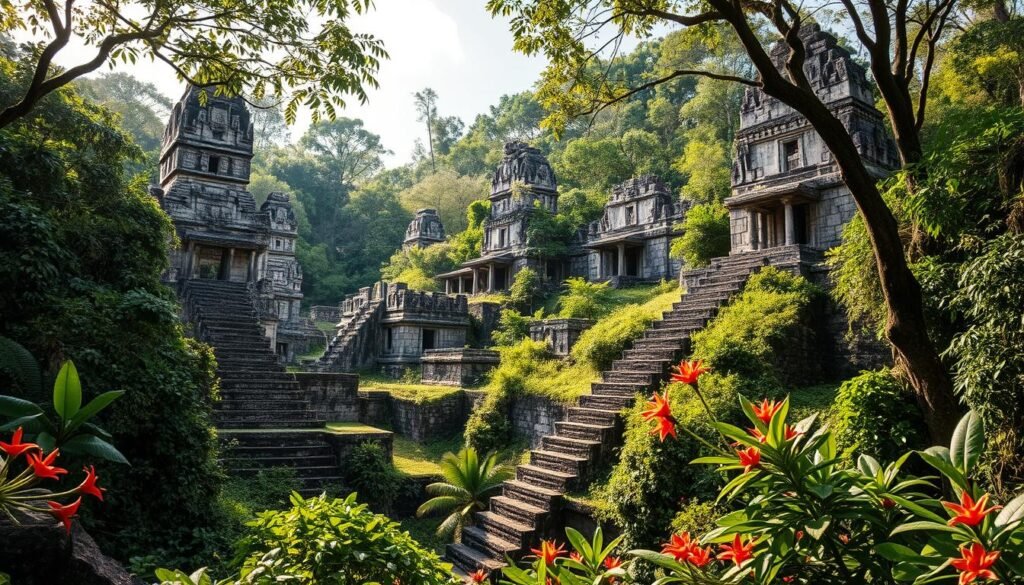
Teotihuacán
Teotihuacán, known as the “City of the Gods,” is a treasure trove of history. It welcomes over two million visitors each year. The Temple of the Sun, one of the world’s largest pyramids, offers breathtaking views. At its height, Teotihuacán was home to 150,000 people, showcasing advanced urban planning and deep cosmic beliefs.
Palenque
Palenque, hidden in the Chiapas jungle, is famous for its detailed stone carvings and architecture. It attracts over a thousand visitors daily. Unlike other sites, Palenque’s seclusion offers a unique exploration experience. As a UNESCO World Heritage Site, it’s a testament to the ancient Mayans’ ingenuity.
- Ancient Mayan Ruins
- UNESCO World Heritage Sites
- Mexico Historical Landmarks
| Site | Annual Visitors | Key Feature |
|---|---|---|
| Chichén Itzá | Large crowds in summer | El Castillo Pyramid |
| Teotihuacán | 2,000,000+ | Temple of the Sun |
| Palenque | 1,000+ daily | Intricate Stone Carvings |
2.) Visit Zócalo
Mexico City’s main square, known as La Plaza de la Constitución, is the cultural heart of Mexico. It’s part of the UNESCO Site of the Historic Centre of Mexico City. The square is surrounded by important sites like the Mexico City Metropolitan Cathedral and the National Palace.
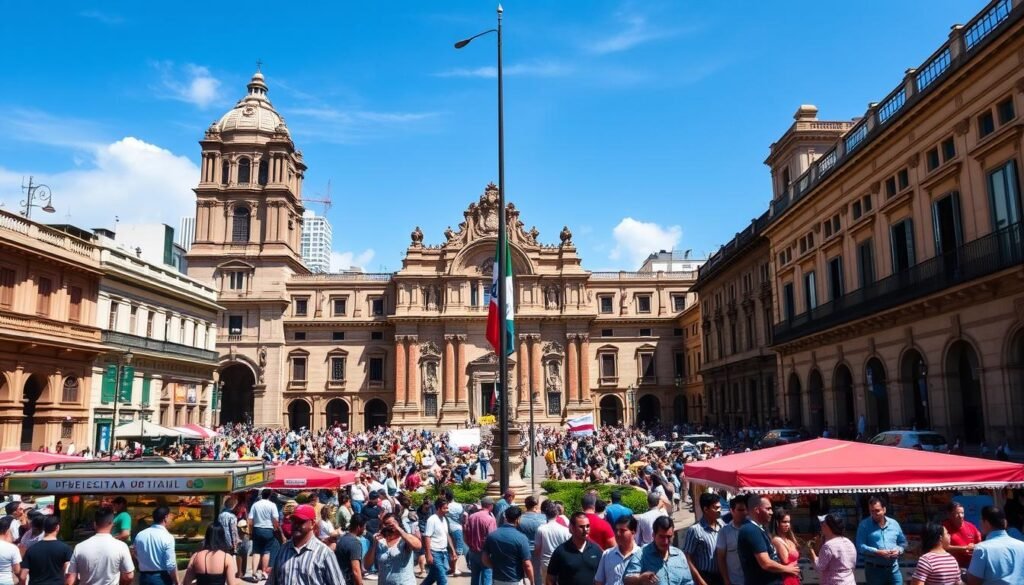
The Zócalo square has a rich history, dating back to the Aztec capital Tenochtitlan. In the 1990s, it got a $300,000,000 makeover. It’s one of the largest public squares in the world, hosting parades, protests, and celebrations. Visitors can explore the Palacio de Bellas Artes, opened in 1934. They can also try sweets from Dulcería de Celaya, a shop since 1874. Churrería el Moro, started in 1935, is famous for its churros. El Templo Mayor is nearby, with 13 levels built between 1375 and 1519. The museum next to it shows artifacts from excavations. The Torre LatinoAmericana, built in 1956, offers stunning views of the city. When visiting, be careful of pickpockets and scammers. The Zócalo metro station on Line 2 makes it easy to get there. This cultural heart of Mexico is a must-see.
| Attractions | Year Established | Description |
|---|---|---|
| Templo Mayor | Excavation began in 1978 | Historic Aztec ruins with 13 construction levels from 1375-1519 |
| Dulcería de Celaya | 1874 | A sweet shop selling over 150 different sweets and desserts |
| Torre LatinoAmericana | 1956 | A skyscraper that withstood major earthquakes and offers city views |
| Palacio de Bellas Artes | 1934 | Host of exhibitions and performances, including the Ballet Folklorico de Mexico |
| Churrería el Moro | 1935 | Family-owned café famous for churros |
3.) Enjoy Mexican Beaches
Mexico’s beaches are known for their beauty and unique experiences. They are among the top tropical vacation spots worldwide. From the Caribbean Sea’s clear waters to the Pacific coast’s rugged charm, these beaches offer relaxation and adventure. Let’s explore some iconic beaches to visit in Mexico.
Cancun and Tulum
Cancun and Tulum are top tropical spots. They sit on Mexico’s Caribbean coast. Cancun has electric-blue waters, pristine beaches, and a lively nightlife. Tulum offers a laid-back vibe with a focus on eco-tourism. In Tulum, you can see ancient Mayan ruins on a cliff overlooking the sea. This creates a stunning backdrop for your tropical getaway.
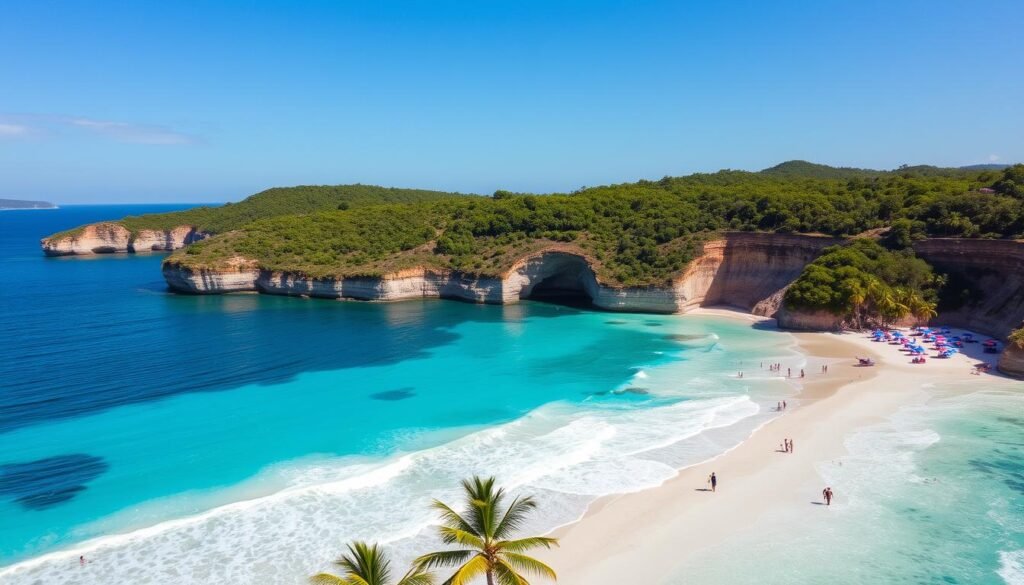
Puerto Vallarta
Puerto Vallarta is on Mexico’s Pacific coast. It blends traditional charm with modern amenities. This city is a cultural hub and welcomes LGBTIQ+ travelers. The city’s beaches offer snorkeling, whale watching, and relaxing under a palapa. It’s a great place to see Mexico’s natural beauty and vibrant culture.
Hidden Beach
Hidden Beach, or Playa del Amor, is a unique spot. You can only get there through a water tunnel. It’s a gem in the Marietas Islands near Puerto Vallarta. The journey to Hidden Beach is an adventure. It’s surrounded by cliffs and clear waters. It’s a private sanctuary for nature lovers. Hidden Beach is a secret spot for a peaceful vacation.
| Beach Name | Location | Features |
|---|---|---|
| Cancun | Quintana Roo | Electric-blue waters, vibrant nightlife |
| Tulum | Quintana Roo | Ancient ruins, eco-tourism |
| Puerto Vallarta | Jalisco | Cultural hub, LGBTIQ+ friendly |
| Hidden Beach | Nayarit | Secluded, eco-tourism |
In conclusion, Mexico’s beaches offer something for everyone. From Cancun and Tulum’s lively spots to Hidden Beach’s tranquility, there’s a beach for every traveler. Mexico’s beaches are a journey through paradise.
4.) Experience Day of the Dead (Día de Muertos)
The Day of the Dead (Día de Muertos) is a chance to dive into Mexico’s rich culture. It was named a UNESCO intangible cultural heritage in 2008. This festival is more than just an event; it’s a deep cultural expression that touches everyone.
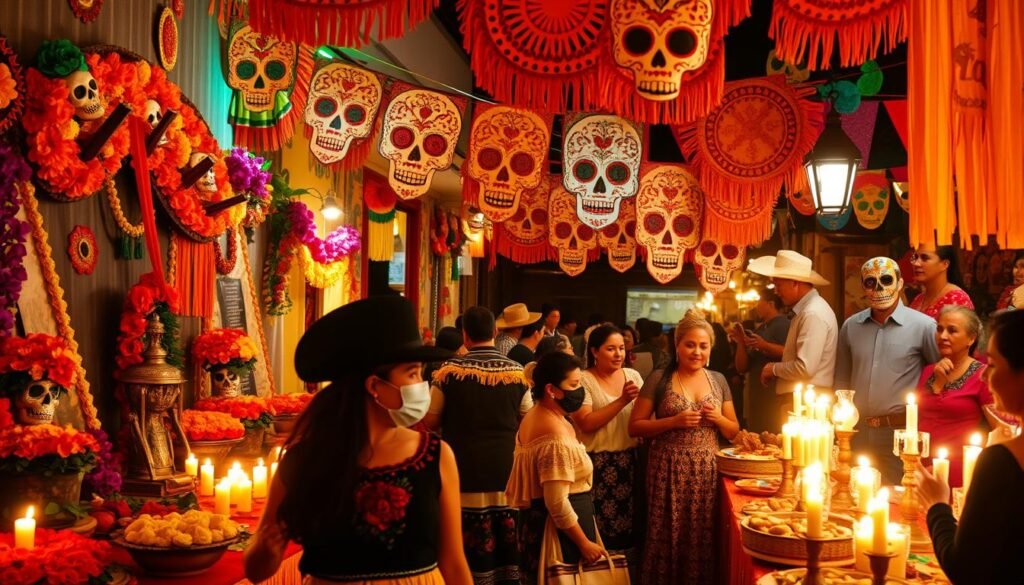
Cultural Significance
Day of the Dead is a celebration of love and remembrance for those who have passed. It’s held on November 1st and 2nd. Families set up ofrendas with photos, mementos, and papel picados to honor their loved ones. Traditional foods like pan de muerto and sugar skulls add to the festive atmosphere. It’s a mix of solemn reflection and joyful celebration, showing the heart of Mexican culture.
Top Locations
Mexico City and Oaxaca are the best places to see the Day of the Dead. Mexico City’s Desfile de Día de Muertos, starting in 2016, is a highlight. It features parades with calaveras and colorful costumes. Oaxaca’s Panteón de San Miguel is the biggest graveyard, decorated with marigold flowers and candles. Mérida’s Paseo de las Animas starts the festivities on October 31st, welcoming everyone to join in.
Unique Festivities
Day of the Dead is known for its unique and captivating activities. In San Luis Potosi, the Xantolo festival combines Indigenous Huastec culture with Mexican traditions. It includes the sacrifice of animals as part of the rituals. The Teotihuacán Pyramids host the Festival Chaman Teotihuacán with hot air balloons, candlelight ceremonies, and pottery classes. These events give a rare look into Mexico’s cultural heritage, making it a memorable experience. Mexico City International Airport connects to 52 domestic and 50 international destinations. Mérida International Airport receives flights from cities like Houston and Los Angeles. Booking your trip early is wise, as places fill up quickly during this time.
5.) Degustation of Mexican Street Food
Mexican cuisine is known for its bold flavors. This is seen in the street food culture of Mexico. From bustling stalls in Mexico City to lively markets in Oaxaca, there’s a wealth of local treats. These dishes show the country’s rich culinary heritage.
Popular Dishes
Some top dishes include tacos, tamales, and quesadillas. Tacos are a favorite, with many types like tacos de papa and tacos al pastor. Tamales, with their Aztec roots, are made from corn masa and filled with everything from meats to fruits.
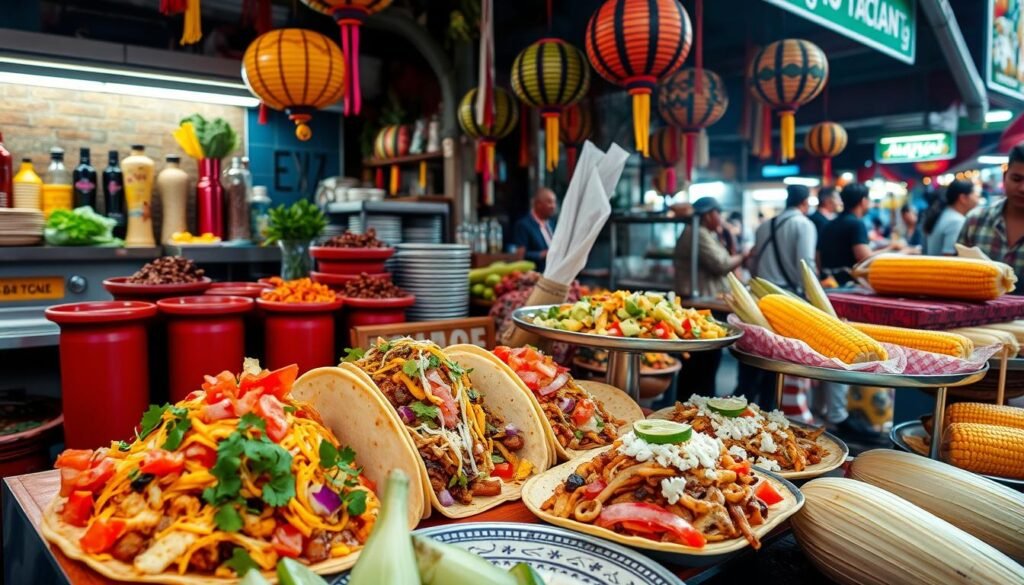
Quesadillas, often filled with cheese, also have authentic versions without it. Other must-try dishes are tlacoyos, tlayudas, tortas, huaraches, sopes, gorditas, and elotes. These dishes highlight the variety of Mexican cuisine.
Top Street Food Locations
Mexico City is a hotspot for street food. Its busy stands are a sign of their popularity. Each taco stand has its own style, from the grill to the signage. Oaxaca is famous for its traditional dishes like tlayudas. Guadalajara and Monterrey also have unique street food scenes. Each adds its own flavor to Mexican cuisine.
Food Markets
Food markets are key to Mexican cuisine. Places like Mercado de la Merced and Mercado Roma in Mexico City offer fresh ingredients and diverse flavors. These markets are cultural landmarks where tradition and taste meet. Street food vendors serve dishes like barbacoa and birria. They use traditional methods like slow roasting. The presence of women cooking on comals shows the community aspect of these markets.
What to do in Mexico: Top 5 Things to Experience
Our journey in Mexico starts in Mexico City. This city is alive with history, culture, and modern life. It has museums, landmarks, and architecture that show both old and new Mexico. Then, we visit Chichen Itza, a UNESCO World Heritage Site. For about $25 USD, you can see this ancient city from 8:00 AM to 4:30 PM. It’s a chance to see the Mayans’ amazing work, like El Castillo.
Next, we head to Palenque in Chiapas. For around $15 USD, you can explore the Mayan history from 8:00 AM to 4:30 PM. The jungle setting makes it a highlight for history lovers. The Copper Canyon region is next. It’s a natural wonder you can see by train, known as “El Chepe.” The 16-hour trip offers breathtaking views and fun activities like ziplining. Xcaret is our last stop. It’s a park that shows Mexico’s natural beauty. For about $100 USD for adults and $55 USD for kids, you can snorkel, swim in underground rivers, and see Mayan ruins. Mexico offers a mix of history, nature, and fun. These places make it a great choice for anyone looking for unique and exciting experiences.
Float in Subterranean Cenotes
The Yucatán Peninsula is famous for its natural swimming holes in Mexico. These spots are perfect for eco-friendly water activities. Cenotes, or natural limestone sinkholes, are filled with crystal-clear waters. These stunning natural pools are great for swimming, snorkeling, and diving. They are a top attraction in the Yucatán Peninsula.
Cenotes in the Yucatán Peninsula
Cenotes in the Yucatán Peninsula come in three types: cave, semi-open, and open. There are also dry cenotes. The Sistema Sac Actun is the world’s longest underground river, over 200 miles long. Cenotes are found in Quintana Roo, near Tulum, Coba, Playa del Carmen, and Puerto Morelos. In Yucatán, many are around Valladolid.
Top Cenotes to Visit
Some cenotes are more popular than others. Dos Ojos Cenote near Tulum is a favorite. Its water is always 25 degrees, perfect for swimming, scuba diving, and snorkeling. Gran Cenote, also near Tulum, is famous for its underwater formations. You can see sea turtles and bats here.
Here are some must-visit cenotes:
- Cenote Calavera: Offers rock jumping and swimming, with basic amenities available.
- Cenote Escondido: A hidden gem with fewer visitors, featuring a diving platform.
- Kaan Luum Lagoon: A massive open-air cenote that resembles a lake, with calm shallow waters.
- Jardin del Eden: Ideal for jumping into clear water, surrounded by lush vegetation and wildlife.
- Cenote Chaak Tun: Almost entirely covered, known for its dark and eerie atmosphere, requires a guided tour.
- Cenote Azul: Located between Playa del Carmen and Tulum, popular for its clear blue water perfect for swimming.
- Cenote Suytun: An Instagram favorite known for its picturesque beauty.
Exploring these natural swimming holes in Mexico is a chance for eco-friendly water activities. It also connects visitors to the history and culture of these formations. Whether you love adventure or history, the cenotes of the Yucatán Peninsula are a refreshing and captivating experience.
Admire the Scenic Beauty of Hierve el Agua
Hierve el Agua is a natural wonder in Mexico. It’s in Oaxaca and draws many visitors. The springs have created rock formations that look like waterfalls, making it a standout spot. Hierve el Agua reopened in November 2021. A private ride costs $75 per person. This includes gas, water, beer, mezcal, and entrance fees. You can also take a public bus for $1 to Mitla and then a camioneta for $2 to get there. The parking fee is 50 MXN ($2.50 USD). Solo visitors pay an extra 25 MXN (about £1) for entry.
Hiking to the pools is rewarding but needs proper shoes. Hike early to avoid heat. The hike to Cascada grande and chica takes about 40 minutes one way. Swim in the infinity pools early to avoid crowds. Stop at Comedor Citlaly for a wholesome breakfast before hiking. A tour that includes Hierve el Agua and a mezcal factory costs about 500 pesos (about £25). Hierve el Agua is an amazing spot in Oaxaca but faces environmental threats. Its pools are at risk due to criminal activities. Mindful tourism is key to preserving this place for the future. Hierve el Agua is open from 08:00 am to 18:00 pm. We encourage you to visit and help preserve this natural wonder.
Discover Mexican Artisan Traditions
Exploring the cultural heritage of Mexico reveals a world of traditional Mexican crafts. These crafts show the country’s rich history and diverse art. You can see these crafts come to life in artisan workshops all over Mexico.
Handicrafts
In Mexico, handicrafts vary from intricate textiles by the Zapotecs to pottery from Oaxaca and silverwork from Taxco. Each piece shows the skill and traditions of generations. These traditional Mexican crafts are not just beautiful but also support many artisans, keeping Mexico’s cultural heritage alive.
Workshops
Visiting artisan workshops is enlightening. In places like Oaxaca and San Miguel de Allende, you can learn pottery, weaving, and more. These workshops give insights into artisans’ lives and the cultural value of their work.
Artisan Markets
The lively artisan markets in Mexico, like those in San Miguel de Allende and Guadalajara, are great places to buy authentic crafts. These markets are key to the local economy and let artists share their work. Here, you can find everything from jewelry to textiles, giving a glimpse into Mexico’s creative soul.
| City | Specialty | Key Market |
|---|---|---|
| Oaxaca | Pottery | Mercado Benito Juárez |
| Taxco | Silverwork | Plaza Borda |
| San Miguel de Allende | Textiles | Mercado de Artesanías |
Mexican artisans weave, craft, and create, showing the nation’s vibrant culture. By visiting these artisan workshops and markets, we connect with Mexico’s artisans. We gain a deeper respect for their role in preserving Mexico’s cultural heritage.
Savor Local Beverages
Exploring Mexican beverages is thrilling. You’ll find everything from Mezcal to Tequila, all rich in tradition. Mexican coffee is also a must-try, with its deep flavors from the country’s fertile lands. Let’s explore these iconic drinks that show Mexico’s heart and spirit.
Mezcal
Mezcal is like Tequila’s smoky cousin. It’s made from different agave plants and gets its smokiness from being roasted in pits. This drink connects you to Mexico’s heritage and pleases your taste buds. Try it neat or in a cocktail for a unique experience.
Tequila
Tequila is a favorite drink around the world. It’s mainly made in Jalisco from blue agave plants. You can find everything from young Blanco to aged Añejo, catering to all tastes. Enjoy it as a shot, in a Margarita, or slowly to enjoy its flavors.
Coffee
Mexican coffee comes from states like Chiapas and Oaxaca. It’s known for its strong taste and aroma. The high altitudes and perfect conditions make the coffee rich and satisfying. Enjoy it in a café de olla or as an espresso for a special treat.

